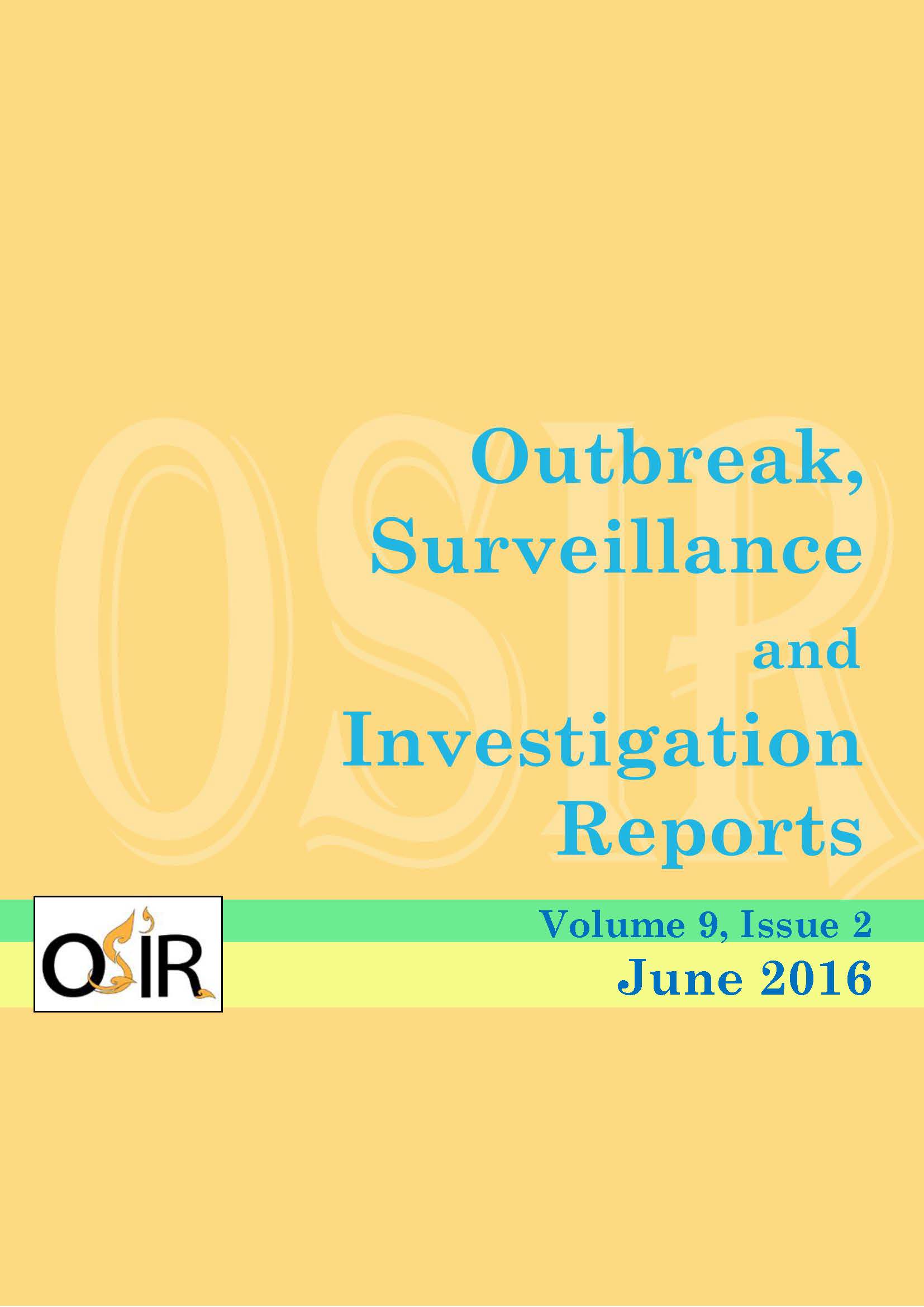Epidemiological Investigation of Visceral Leishmaniasis Caused by Leishmania martiniquensis in a Non-endemic Area of Thailand
DOI:
https://doi.org/10.59096/osir.v9i2.263213Keywords:
leishmaniasis, kala azar, L. martiniquensis, northern ThailandAbstract
On 5 Sep 2013, a patient suspected to have leishmaniasis from Lamphun, a northern province of Thailand, was reported to the Bureau of Epidemiology. An investigation was carried out to identify reservoirs and vectors. Active case finding was carried out among those who lived within 200-meter radius from the patient’s residence. Blood samples were collected from humans, domestic mammals and rodents, and adult sandfly trapping was conducted by light traps. The patient was a 38-year-old man infected with human immunodeficiency virus (HIV) who had worked as a lumberjack and a woodcraftsman. In addition to many kinetoplasts in the bone marrow and amastigote form of Leishmania, Leishmania martiniquensis was identified by polymerase chain reaction (PCR). A total of 12 suspected cases out of 123 surveyed villagers were identified. However, all human specimens were tested negative by direct agglutination test and PCR. Female Sergentomyia sandflies were found. Deltamethrin fogging was done to control the vectors. Visceral leishmaniasis was confirmed in an HIV positive male from northern Thailand. Awareness of leishmaniasis among immunocompromised people should be raised for timely appropriate medical attention and specific vector control for sandflies in the area should be implemented.References
The Center for Food Security and Public Health. Leishmaniasis (Cutaneous and visceral). October 2009 [cited 2013 Oct 7]. <http://www.cfsph.iastate.edu/Factsheets/pdfs/leishmaniasis.pdf>
Sukmee T, Juntasiriyakorn S, Kanjanophas K. Situation of leishmaniasis in Thailand. Weekly Epidemiological Surveillance Report. 2011;42:260-4. Thai.
World Health Organization. Leishmania [cited 2013 Sep 30]. <http://www.who.int/leishmaniasis/en/>
Sukmee T. Leishmaniasis. Weekly Epidemiological Surveillance Report. 2010;41(3s): s49-63. Thai.
Chiewchanvit S, Tovanabutra N, Jariyapan N, Bates MD, Mahanupab P, Chuamanochan M, et al. Chronic generalized fibrotic skin lesions from disseminated leishmaniasis caused by Leishmania martiniquensis in two patients from northern Thailand infected with HIV. Br J Dermatol. 2015 Sep;173(3):663-70. Epub 2015 Jun 1.
Natesuwan S, Viriyaprasopchoke A, Sriwongphan P, Yodprasit P, Chimplee A, Lekhakoon S, et al. Case investigation report: leishmaniasis, Mueng District, Chiang Rai Province from 17 Apr to 30 May 2012. 2012. Thai [cited 2013 Sep 7]. <http://www.boe.moph.go.th/boedb/srrtnetwork/otoo/filen/a10570190120317.pdf>
Alvar J, Aparicio P, Aseffa A, Den Boer M, Cañavate C, Dedet JP, et al. The relationship between leishmaniasis and AIDS: the second 10 years. Clin Microbiol Rev. 2008 Apr;21(2):334-59.
Heymann DL. Control of communicable diseases manual. 19th ed. Washington DC: American Public Health Association, 2008. p. 340-7.
Centers for Disease Control and Prevention. Leishmaniasis. 2013 Jan 10 [cited 2014 Aug 10]. <http://www.cdc.gov/parasites/leishmaniasis/gen_info/faqs.html>
Ridley DS, Ridley MJ. The evolution of the lesion in cutaneous leishmaniasis. J Pathol. 1983 Sep;141(1):83-96.
Pothirat T, Tantiworawit A, Chaiwarith R, Jariyapan N, Wannasan A, Siriyasatien P, et al. First isolation of Leishmania from northern Thailand: case report, identification as Leishmania martiniquensis and phylogenetic position within the Leishmania enriettii complex. PLoS Negl Trop Dis. 2014 Dec 4;8(12):e3339. eCollection 2014.
Lawyer PG, Perkins PV. Leishmaniasis and trypanosomiasis. In: Eldridge BF, Edman JD, editors. Medical entomology: a textbook on public health and veterinary problems caused by arthropod. Dordrecht: Kluwer Academic Publishers; 2000. p. 231-73.
Weihong J, Veitch CR, Craig JL. An evaluation of the efficiency of rodent trapping methods: the effect of trap arrangement, cover type, and bait. New Zealand Journal of Ecology. 1999;23(1):45-51.
Falcão AL, Falcão AR, Pinto CT, Gontijo CM, Falqueto A. Effect of deltamethrin spraying on the sandfly populations in a focus of American cutaneous leishmaniasis. Mem Inst Oswaldo Cruz. 1991 Oct-Dec;86(4):399-404.
Saeidi Z, Vatandoost H, Akhavan AA, Yaghoobi-Ershadi MR, Rassi Y, Sheikh Z, et al. Baseline susceptibility of a wild strain of Phlebotomus papatasi (Diptera: Psychodidae) to DDT and pyrethroids in an endemic focus of zoonotic cutaneous leishmaniasis in Iran. Pest Manag Sci. 2012 May;68(5):669-75. Epub 2012 Feb 20.
Downloads
Published
How to Cite
Issue
Section
License
Copyright (c) 2023 Outbreak, Surveillance, Investigation & Response (OSIR) Journal

This work is licensed under a Creative Commons Attribution-NonCommercial-NoDerivatives 4.0 International License.









